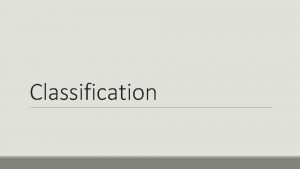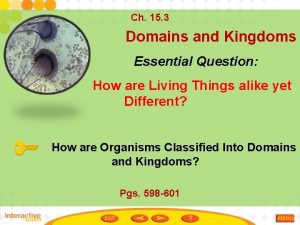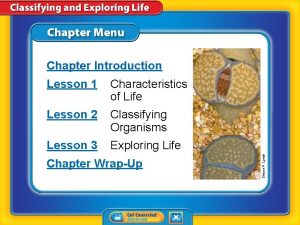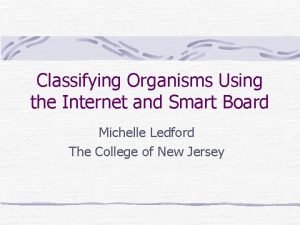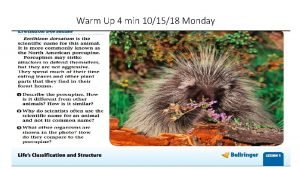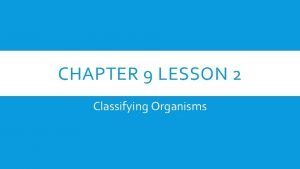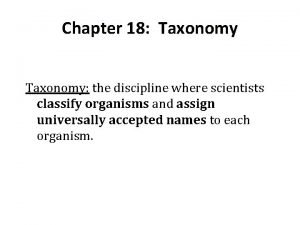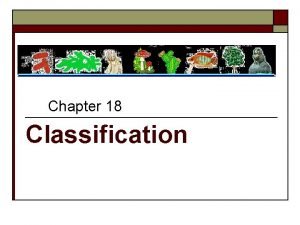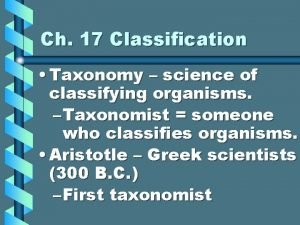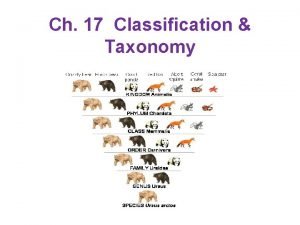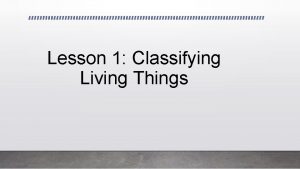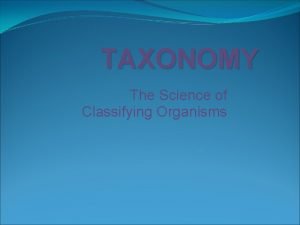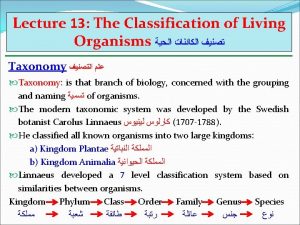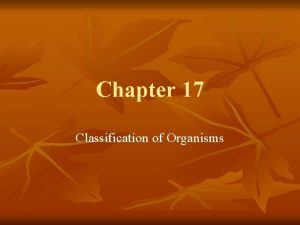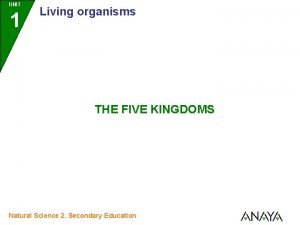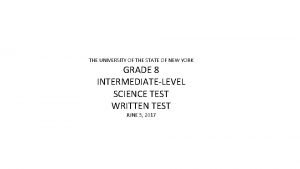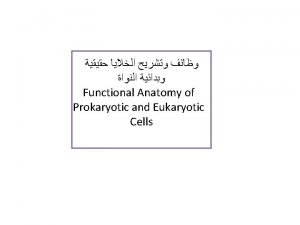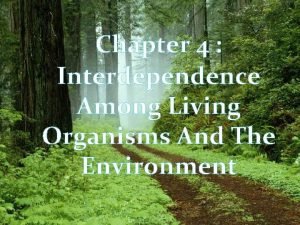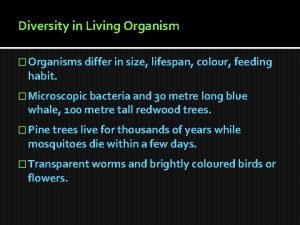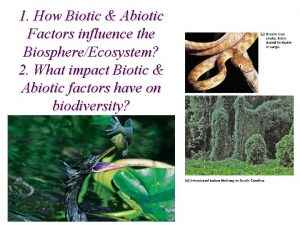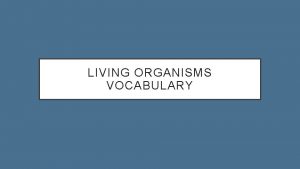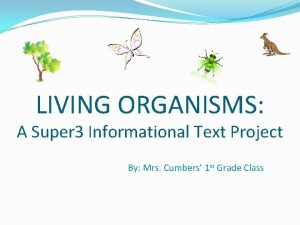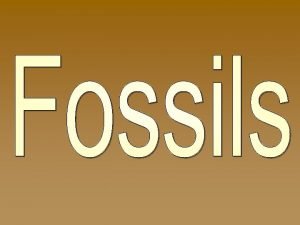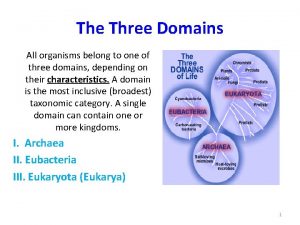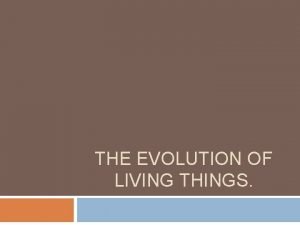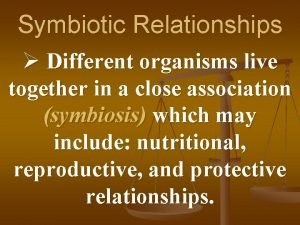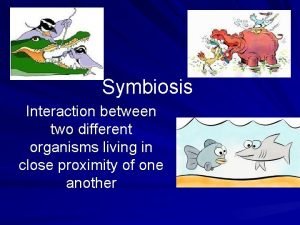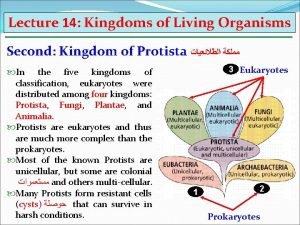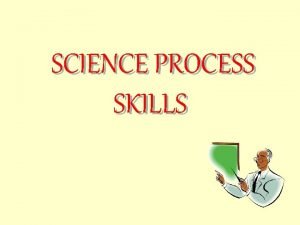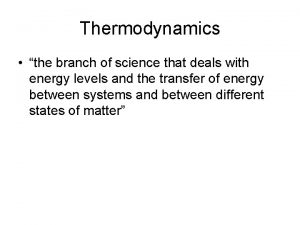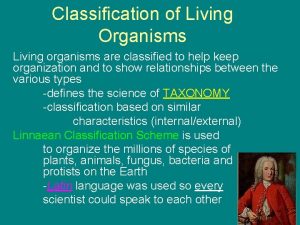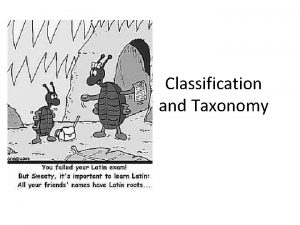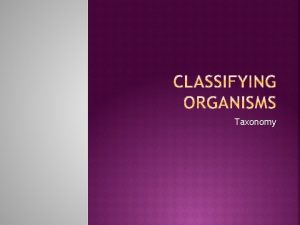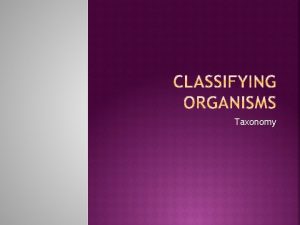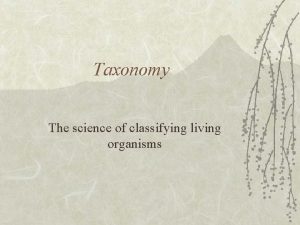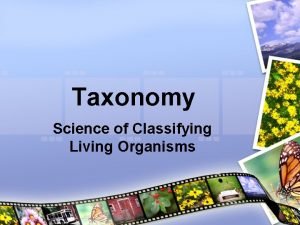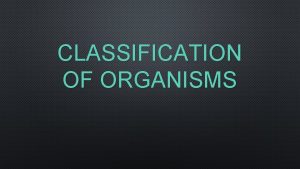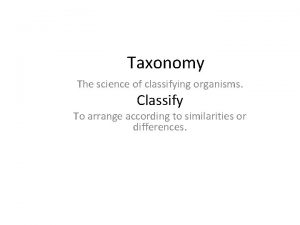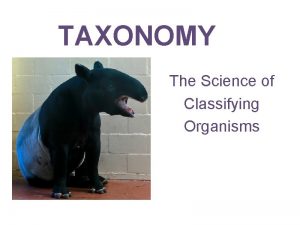Taxonomy Taxonomy Science of classifying living organisms Classified


















































- Slides: 50

Taxonomy

Taxonomy • Science of classifying living organisms – Classified by structure, function or appearance • Father of Taxonomy-Carl Linnaeus – Developed first system – Gave scientific names (Latin) • Binominal Nomenclature – – Two words First word Genus (always capital) Second word Species Always underlined or italicized • Ex: Homo sapiens

Binomial Nomenclature Which TWO are more closely related?

Classification Groupings Kingdom Phylum Class Order Family Genus Species King Phillip Came Over For Grape Soda

Six Kingdom Classification System Least Complex Kingdom Archaebacteria Kingdom Eubacteria Kingdom Protista Kingdom Fungi Kingdom Plantae Kingdom Animalia Most Complex

The Prokaryotes • Kingdoms Arachaebacteria and Eubacteria • General characteristics: – Most numerous organisms on Earth – Microscopic – Prokaryotic-No true nucleus

Prokaryotic Reproduction • Some species of bacteria can reproduce every 20 mins. • Reproduces by Binary Fission -Form of asexual reproduction -Bacterial cells make exact copies of genetic material -Genetic material is distributed to new cells


Kingdom Archaebacteria • • Found in extreme, harsh environments Three Categories: 1. Methanogens- Get energy by converting H and CO 2 into methane gas – Anaerobic – Live at the bottom of swamps, in sewage, and in the intestinal tract of humans and other animals

2. Extreme halophiles- Use salt to generate ATP • • Live in areas of high salt concentrations Great Salt Lake and Dead Sea 3. Thermacidophilies- Live in areas of extremely acidic environments that have extremely high temperatures • Hot springs, volcanic vents, hydrothermal vents


Kingdom Eubacteria • Found everywhere Identification: – Shape: • Three shapes: Bacilli (rod shaped), cocci (sphere shaped) and spirilla (spiral shaped) • Cocci in chains- Streptococci • Cocci in grape-like clusters- Staphylococci


− Functions of bacteria: − Decomposers: Break down dead organisms to recycle nutrients − Nitrogen fixers: Convert nitrogen in the soil to a useable form for plants − Disease: Can break down tissue or release toxins that harm the body − Food Products: Bacteria help make food (cheese, yogurt, buttermilk, sour cream) − Industry: Used to help purify water, digest oil spills, used in sanitation

Bacterial Diseases • Bacteria that cause disease: Pathogens – Attack cells and secrete toxins Types of Bacterial Diseases Tuberculosis (TB): Respiratory disease, bacteria is inhaled. Results in constricted breathing.

• Cholera: Bacteria in contaminated food and water causes. – Results in diarrhea and vomiting • Lyme Disease: Bacteria is carried by the deer tick, which infects mammals AFTER A BITE. – Causes rash, muscle aches and death if not treated.

• Anthrax: Caused by touching, inhaling or eating substances infected with anthrax – If touched (cutaneous)- usually causes skin infection – If ingested (gastrointestinal)- usually causes GI problems – If inhaled (inhalation)- it is almost always fatal – There is a vaccine available for anthrax – Has recently been used as a biological weapon


• Food borne Diseases: Bacteria can attack food – Many illnesses such as E. coli, Salmonella, Hepatitis A, Botulism are caused by bacteria

Treating Bacterial Diseases • 1928 - Alexander Fleming discovered penicillin (mold) on bacteria. – Noticed that the bacteria that was touching the mold was dying – Discovered the first antibiotic – Many people are allergic to penicillin • Your body’s immune system defends against bacterial disease • Immunization also fights bacterial disease

Controlling Bacteria • Sterilization • Refrigeration • Steaming • Canning properly • Proper Sanitation

Viruses • Virology- Study of viruses • Characteristics – – – Non living until they find a host Composed of nucleic acid and a protein coat Smaller than bacteria – Cause disease in host • Two divisions of viruses: • DNA viruses: Has DNA as genetic material • RNA viruses: Has RNA as genetic material • Called a retrovirus • HIV

• Capsid: Protein coat that surrounds the virus – Proteins in capsid trick the host cell into allowing the virus inside – Once inside the cell, the virus takes over the genetic machinery, making more viruses.

Viral Diseases • Diseases and Illnesses caused by viruses include: – HIV: Human Immunodeficiency Virus • Attacks White Blood Cells • Is a retrovirus

• Common cold: Spread by inhaling or ingesting cold viruses (rhinoviruses) • Influenza (flu): Spread by inhaling or ingesting viruses

• Viral pneumonia: Spread by inhaling the virus, may start as a cold – 6 th leading cause of death in the U. S

• Chicken Pox: Spread by inhaling the virus or direct contact with the virus – Has an immunization • Polio: Spread by inhaling the virus, infected food and water – Infection of the spinal cord – Has an immunization

Flu Ward Early 1900’s


Kingdom Protista • Protozoans and algae • Characteristics: – One celled, lives in colony or alone – Microscopic – Contains Organelles – Live in moist environment – Locomotion is by: • • • Cilia Flagella Pseudopod- False Foot

• Classification by means of locomotion: – Phylum Sarcodina • • Move by pseudopods-cytoplasmic streaming Surround food to ingest Reproduce by binary fission (asexual) Ex: Amoeba -Phylum Ciliophora • • • Move by cilia Reproduce sexually-conjunction. Asexually-binary fission Ex: Paramecium

– Phylum Zoomastigina • • • Move by using flagella Feed on dead or decaying matter Some are parasitic Reproduce asexually (binary fission) Ex: Trypanosomes – Phylum Soprozoa • • • No means of locomotion Reproduce asexually by spores Ex: Plasmodium

• Malaria: Diseases Caused by Protists – Caused by plasmodium – Carried by female Anopheles mosquito – Known as “Chills and Fever” disease – 2. 7 million people die from each year – Causes kidney failure and coma if not treated

• Malaria Life Cycle: Mosquito Salivary glands Stomach of mosquito Spores in blood Human Red Blood Cells

• African Sleeping Sickness: – Caused by the trypanosome Trypanosome gambienese – Carried by the Tsetse fly – Causes fever, swollen glands, anemia, coma or death (if enters CNS) – Life cycle is similar to malaria

• Amoebic Dysentery – Caused by the amoeba, Entamoeba histolytica – Transmitted by contaminated drinking water – Affects intestinal walls forming cysts and causing diarrhea – Cysts are excreted in feces – Common in areas where no sewage treatment is found or human waste is used as fertilizer

Plant Like Protists Phylum Example Euglenophyta Euglena Dinoflagellates Chlorophyuta Green algae Phaeophyta Brown algae, kelp Rhodophyta Red algae Chrysophyta Golden-brown algae, diatoms


Kingdom Fungi • Characteristics of all Fungi: – Eukaryotic -Cell walls made of chitin -Some are parasites – Some are commensal or mutalistic – Heterotrophic – Mostly decomposers – Fungi as hetertrophs feed on decaying matter – Fungi as decomposers recycle nutrients

Phylum Ascomycota • • Sac fungi Most are multi-cellular, yeast is unicellular Sexual reproduction by spores, asexual reproduction by budding Penicillium, aspergillus (bread mold) yeast, truffles, morels and ergot

Phylum Basidiomycota • • Club fungi Sexual reproduction by basidiospores Basidiocarp-reproductive structure (above ground) Ex: Mushrooms, puffballs, rusts, smuts, bracket fungi

Phylum Deuteromycota • • • Imperfect fungi No sexual stage, only reproduce asexually Ex: Ringworm

Fungi as Parasites • Cause plant diseases such as corn smut, mildew and wheat rust • Cause human diseases such as athletes foot, ringworm, toenail infections and yeast infections

Symbiotic Relationships • Lichen: Mutualistc relationship between fungus and green algae (plant) or a cyanobacteria – Indicate air pollution – Pioneer plants • Mycorrhiza: Mutualistic relationship between a fungi and plant roots – 90% of plant roots – Fungus increases surface area for root absorption – Fungus receives sugar from plant

• Paramecium • Ameoba • Euglena

Evolution and Taxonomy What is Evolution? • Changes in biodiversity over periods of time

Common Misconceptions About the Theory of Evolution • Darwin developed theory of evolution The theory of evolution was developed before Darwin began his studies. Darwin developed theory of Natural Selection • The theory of evolution means that humans evolved from monkeys Evolution means change in a species over long periods of time, not the development of entire new species. • Evolution is against religion Evolution is a scientific theory, not a religion based upon faith.


Microevolution Small-scale changes of genes in a population over a few generations. Caused by: – – – Mutations Natural Selection: Process where organisms with favorable variations reproduce more than those organisms without the variations. Developed by Darwin. Ex: Kingdom Archaebacteria Artificial Selection: Human breeding organisms to produce certain characteristics. Ex: Vegetables, dogs

Genetic Drift Change in allele (copy of a gene) frequencies of a population due to chance. Environmental factors usually cause. – A type of microevolution • Ex: Bacteria that become resistant to antibiotic, viruses mutate in your body – Can be observed, so is an accepted Scientific idea – Does not give rise to a new species
 Cat classification chart
Cat classification chart The science of naming and classifying organisms
The science of naming and classifying organisms Difference between living and non living organisms
Difference between living and non living organisms Taxonomy is the science of grouping and naming organisms
Taxonomy is the science of grouping and naming organisms How are organisms classified into domains and kingdoms
How are organisms classified into domains and kingdoms Lesson 2 classifying organisms answer key
Lesson 2 classifying organisms answer key Classifying organisms worksheet
Classifying organisms worksheet Lesson outline classifying organisms
Lesson outline classifying organisms Lesson 2 classifying organisms answer key
Lesson 2 classifying organisms answer key Fungi cell
Fungi cell Discipline of classifying and naming organisms
Discipline of classifying and naming organisms Why do scientists classify organisms?
Why do scientists classify organisms? Kingdom animalia cladogram
Kingdom animalia cladogram Discipline of classifying and naming organisms
Discipline of classifying and naming organisms What is the hierarchical system used to classify organisms?
What is the hierarchical system used to classify organisms? Why do organisms interact with other organisms
Why do organisms interact with other organisms Unicellular and multicellular.
Unicellular and multicellular. Classifying living things lesson 1 answer key
Classifying living things lesson 1 answer key Organisms taxonomy
Organisms taxonomy Order of classification of organisms
Order of classification of organisms Most general to most specific classification
Most general to most specific classification 8 major levels of classification
8 major levels of classification Taxonomy in biology
Taxonomy in biology What are the 5 kingdoms of living organisms
What are the 5 kingdoms of living organisms Why do amebas need to obtain food
Why do amebas need to obtain food Different types of living organisms
Different types of living organisms Modern classification of living organisms
Modern classification of living organisms Types of living organisms
Types of living organisms Planaria, liverfluke, tapeworm, ascaris *
Planaria, liverfluke, tapeworm, ascaris * Living organisms and their surroundings
Living organisms and their surroundings Two different organisms living together
Two different organisms living together Six kingdoms of life
Six kingdoms of life What is the smallest unit of living organisms
What is the smallest unit of living organisms Living organisms
Living organisms Different types of fossils
Different types of fossils Three domains of life
Three domains of life Evolution of living organisms
Evolution of living organisms Two different organisms living together
Two different organisms living together Close interaction between two different organisms
Close interaction between two different organisms Small living creatures tom
Small living creatures tom Kingdom protists
Kingdom protists Remains, imprints or traces of once-living organisms
Remains, imprints or traces of once-living organisms The smallest living unit of all living things is
The smallest living unit of all living things is Marzano and kendall new taxonomy
Marzano and kendall new taxonomy It is my favourite subject
It is my favourite subject Examples of scientific skills
Examples of scientific skills Classifying science process skills
Classifying science process skills Shell living or nonliving
Shell living or nonliving Living non living dead
Living non living dead Thermodynamics is a branch of science which deals with
Thermodynamics is a branch of science which deals with Taxonomy is the branch of science that deals with –
Taxonomy is the branch of science that deals with –

